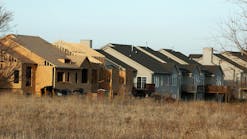Invisible Structures Inc.
undefinedThe Iowa State Fair in Des Moines, Iowa, draws more than 1.1 million visitors each year from all over the country. The 450-acre facility has been in operation since 1878 at this location, and it hosts events all throughout the year. Its busiest venue is the Varied Industries Building, which is surrounded by a large open area that hosts food vendors, fairgoers, displays and exhibits. Unfortunately, during many events, rain and traffic would cause the grass to turn into a muddy, rutted mess. After the event was over, extensive re-grading and reseeding were ultimately necessary to repair the area.
A grant from the Ruan Foundation was set up for improvements to the plaza that connects Grand Avenue with the Jacobson Exhibition Center. Scott Worth, senior plant operations director at the fair, put together a multi-disciplinary team consisting of Keffer/Overton Architects, Kirkham Michael & Associates (civil engineers) and P&E Electrical Engineers. Scott Almeida, P.E., of Kirkham Michael was in charge of designing the infrastructure for the new plaza. Almeida’s design included a plastic grass paver to support the lawn area. Almeida chose Grasspave2 from Invisible Structures Inc., a flexible, plastic, ring-and-cylinder structure made from 100% recycled plastic. The grass paver can support extremely heavy loads (15,940 psi) and protects the grass roots from compaction.
“It is a multipurpose space,” Almeida said. “[It is] Flexible and adaptable to the fair’s needs.”
The fair can use the plaza for an agricultural expo one week, host a craft fair the next and then use it for concert parking a few days later.
The plaza redevelopment has three stages, and the grass paver will be installed in all three. Phase I had 44,000 sq ft installed in the summer before the fair in 2015. Phase II, with 18,200 sq ft of grass paver, is scheduled for installation as soon as the snow melts. Finally, Phase III will begin after the 2016 fair and add an additional 13,000 sq ft. Almeida’s cross-section of the grass paver system consists of 12 in. of sandy-gravel base course, the Grasspave2 product, sand to fill the void spaces of the grass paver and a thin-cut sod rolled out on top. The paver system also protects a host of underground utilities for event and vendor amenities such as water, electrical and telecommunications.
The grass paver system was host to the first fair in August of 2015 and saw its share of heavy traffic, including food trucks, utility trucks, semis, video/television equipment and even a grain silo as a display. Since the fair and setup lasted two weeks, the area couldn’t be irrigated for the duration.
“It [the grass] came back,” Almeida said. “It took about two weeks for it to recover.”
Due to the intense summer heat, the grass that had not been irrigated had turned dormant and dried out during the fair. However, because the grass paver protects the root zone from compaction, after irrigation resumed, the grass recovered.
According to Almeida, this was his first chance to utilize Grasspave2 in on a project after knowing about the product for ten years. There are other types of porous paving at the fairgrounds that have not performed well, and therefore the Fairgrounds team members were skeptical about installing another one. It took some convincing by the firm that the Grasspave2 system would work when others had not.
Country Landscapes Inc. of Ames, Iowa, performed installation of the grass paver system. According to Trever Ewalt, project manager with the company, the success of the system and rapid recovery of the grass after the fair allowed for more installations in phases II and III.







